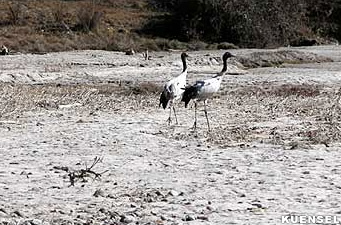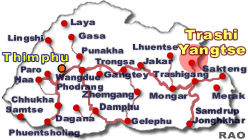|
Bhutan's
Nature - Animals
|
 |
Bhutan Nature Animals |
|
 |
Bhutan Information |
|
|
 |
 |
| The two adults arrived in Bomdelling on October 30, 2006
The
Blacked necked cranes have begun arriving in Bumdeling valley, Trashiyangtse,
one of the two winter roosting grounds in Bhutan.
The
first of these long legged birds, two adult cranes, touched down in Bumdeling
at around 3.00 pm on October 30 after a flight of hundreds of miles from
the Tibetan plateau. The
Bumdeling Park Ranger, Tenzin, said that the cranes had arrived
earlier this year. |
|
In 2005 the first of the cranes arrived on November
6, 2006
The
cranes feed on the roots of harvested paddy and other plants off the valley
floor.
Ranger
Tenzin said that there was a general concern in the gewog of the damage
to the roosting areas by the regular flooding of the Kholongchu.
Plans
to start winter cropping in the valley was another concern.
 |
Park
officials said that the number of cranes coming to the valley was decreasing
every year because of the damage by the floods and increased development
works in the gewog.
On
October 29, the nature club members of Bailing Higher Secondary School,
Tashi Yangtse Lower Secondary School, gups and chimis and officials of
Bumdeling Wild life Sanctuary cleaned the roosting areas in Bumdeling.
|
Last
year, a golden eagle had killed a crane in the roosting area said ranger
Tenzin.
The
cranes usually migrate to Bhutan in November and go back to Tibet in March.
Last year, 141 cranes roosted in Bumdeling.
The
last group of cranes come in by December.
The
Phobjikha valley in Wangduephodrang dzongkhag is another roosting area
for the cranes in Bhutan.
top
| Black
Necked Cranes |
 |
In
Bhutan the Black Necked crane locally known as the Thrung Thrung Karm is deeply revered as a heavenly bird and a harbinger of good luck. The
crane appears in Bhutanese folklore, songs, dances and historical references.
Of
an average height of 1.5 metre with a distinctive black neck,
and a life span of 70 to 80 years, the cranes feed on plant roots
and tubers on wetlands and shores of lakes and ponds.
They breed
in northern Tibet in the summer and make the journey to Bhutan and
the Indian states of Arunchal Pradesh and Ladakh between October to January
for the winter and leave by March and April. The Phobjikha valley in Wangduephodrang is another roosting area for the cranes in Bhutan.
Once
abundant in parts of China, Bhutan and India, black-necked crane (Grus
nigricollis) numbers have dwindled in recent decades, and, as a result,
have been listed on the IUCN red list of endangered species. It is estimated
that there are only 5,000-6,000 cranes left in the wild. The wetlands of
Bhutan and southern Tibet are the wintering sites of these birds, while
northern Yunnan and the eastern part of Ladakh in India serve as their
breeding grounds.
With only
6,000 cranes left in the world the birds are listed as an endangered
species. In 1998 the Royal Society for Protection of Nature and the
International Crane Foundation (ICF) USA, collared four cranes with radio
bands to study their migration route. One of the four collared cranes were
sighted in southern Tibet in February 2002.
| Contributed
by KUENSEL, Bhutan's National Newspaper 2006 |
 |
top
| Wildlife and People in Bhutan |
 |
| Information on Bhutan |
 |
| Links |
 |
 |
 |
External
links |
|




